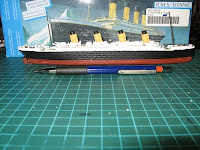So December is just on the horizon and that means two things:
- time for a post and
- I better have the Christmas tree layout nearly ready.
Well the good news is that trains have recently done multiple laps of the layout successfully. The not so good news is that after getting the bridge track fixed to the trestle bridge and then the joining pieces matched up to provide nearly seamless trackage, I have started on further enhancements to the visual appearance of the layout.
So far :
- the track has been rust painted (and the guide rails too)
- the tunnel interiors have been painted dark brown
- a layer of plaster has been applied to the mountains to cover gaps and add further features to the mountains
- the trestle bridge was painted a more woody and less matchsticky brown prior to fixing the bridge track
Over the next few days (mostly nights really) I plan to:
- glue the guide rails to the bridge track
- paint the sleepers a consistent brown and while doing so cover any glue and nails/track pins
- sculptamold the areas of scenery that have not been augmented by plaster as above
- cover the "snow scaped" scenery with some form of snow material, having most recently seen this at Fisher Discounts
It all looks like being "on track" as it were. When the 0-6-0 that I like to think of as a substitute 4466 ran smoothly around the tracks and then with a boxcar and train of three overton coaches did the same thing, it was a beautiful moment of model railroading. Especially with my daughter at my side eager to see the train go in and out of the tunnels and over the bridge. Another beautiful moment occurred when my Berkshire (never run on Union pacific but this is my railroad and she does look good in UP colours) also ran the length of the bridge smoothly and with ease. The downer being that on the minimum radius parts of the ellipse that occur near the tunnels combined with the narrow tunnel portals to make the locomotives overhang too much for her to go all the way around.
To me the running of trains is one of the magic moments of model railroading. I like making the models and completing a project and so many aspects of model railroading but my favourite part is just watching trains in motion. Canberra is a place this doesn't happen an awful lot compared to when we lived next to or near the Ipswich rail line in Brisbane which had the beauty of being a passenger and freight line as well as being on the way to the Ipswich Railway Workshop so a steam locomotive was not out of the question. So for now, much of my enjoyment of trains comes through my modelling. That will have to be enough good times and memories in miniature and life size for this entry, night all.


























































